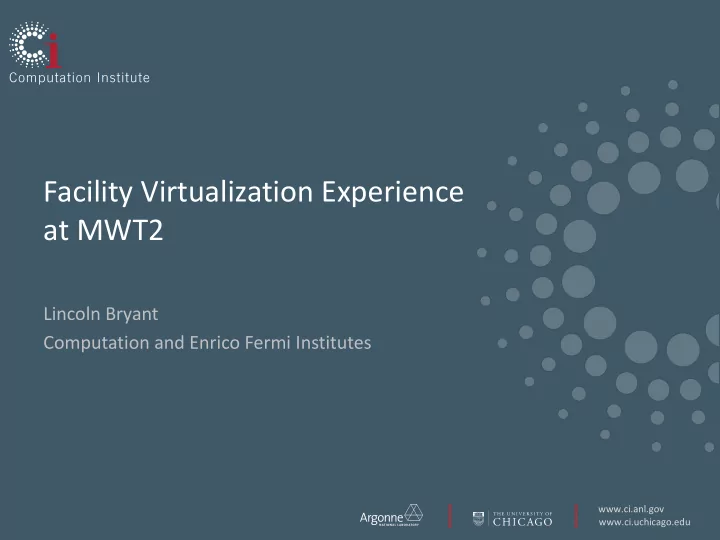

Facility Virtualization Experience at MWT2 Lincoln Bryant Computation and Enrico Fermi Institutes www.ci.anl.gov www.ci.uchicago.edu
Introduction • We were asked to set up a virtual Panda queue at Midwest Tier 2 • I'll speak about provisioning a virtual cluster and setting up the panda queue • I'll show off some performance assessments of the queue. • And finally I'll look at some future technologies, and how we can evolve this project into a cloud platform for MWT2. www.ci.anl.gov 2 www.ci.uchicago.edu
What is the current infrastructure at MWT2? • Cobbler (PXE images, repos, DHCP) and Puppet (post-install configuration). • We have four hypervisor machines between IU and UC. • Each hypervisor is a Dell R710 with 24 logical CPUs and 96 GB of RAM • Our hypervisors run virtual head node services (gums, srm, mysql, condor, etc..) www.ci.anl.gov 3 www.ci.uchicago.edu
MWT2 Node Provisioning Infrastructure iut2-c... uct2-c... iut2-c... uct2-c... iut2-c... uct2-c... iut2-c... uct2-c... DHCP PXE Repos Cobbler Puppet uct2-puppet uct2-bootstrap uct2-grid10 / uct2-grid11 Virtual Machine Hypervisors (* UIUC nodes provisioned a bit differently at the moment) www.ci.anl.gov 4 www.ci.uchicago.edu
What sort of infrastructure do we need for a virtual queue? Two paradigms: • – Go through the entire installation process for each VM and do post install configuration – “Bake in” everything we need into a VM image and deploy We could have chosen do the former, but the latter makes more sense • for a cloud deployment. (Plus we get the image for free from BNL) • Instead of potentially swamping our hypervisors providing head node services, we chose to refit our standard R410 worker node. – Given 24 logical cores and 48 GB of RAM, each hypervisor should be able to host 4 or 5 virtual workers with some room left over for the hypervisor itself • We'll also need to set up a Panda queue, AutoPyFactory, and a Condor head node. www.ci.anl.gov 5 www.ci.uchicago.edu
What tools do we need to build a virtual queue? • Standard stuff like DHCP, DNS, etc. – Cobbler does a reasonable job at this and is already well integrated into our infrastructure. • Some sort of virtualization layer. – BNL uses OpenStack. That seems like a good starting point. o On the other hand, OpenStack requires a little R&D. – We've been using libvirt + KVM for a while. Why not try that? • Some sort of tool to configure the workers. – Puppet is useful for configuring nodes post-install, but it would be much nicer to just start out with our workers prefabbed. – Enter BoxGrinder. www.ci.anl.gov 6 www.ci.uchicago.edu
Pros and Cons of BoxGrinder • Pro: – Very nice tool for building virtual machines that work out of the box – Appliance definition supplied by BNL creates functional worker nodes with minimal configuration on our part. • Con: – Can't easily leverage our existing Puppet infrastructure – Supports libvirt, but the plugin is still immature – RHEL-variants aren't supported. Need to use Fedora. – Or do we? www.ci.anl.gov 7 www.ci.uchicago.edu
Boxgrinder: Trials & Tribulations • We're an SL shop – why not try to build BoxGrinder for SL 6? – Surprisingly easy! Only needed to rebuild the appliance-tools RPM from Fedora 17 – The rest of the dependencies were installed via Ruby Gems and YUM • BoxGrinder's libvirt support is a bit rough around the edges – BoxGrinder makes incorrect assumptions about our network configuration. – Need to use a sed script to inject kernel console parameters. – VMs need to be re-imported by hand with virt-install and have their MAC addresses added to Cobbler's DHCP server – Clearly a hurdle if we want to scale up. www.ci.anl.gov 8 www.ci.uchicago.edu
ANALY_MWT2_CLOUD Queue and Head Node Configuration • Standard Condor head node with minor changes to BNL's configuration • We were able to copy BNL_CLOUD as a template for ANALY_MWT2_CLOUD • Small problem with AutoPyFactory installation. – As it turns out, a required RPM (python-simplejson) went missing in EPEL for SL5. – John and Jose found the required RPM and put it in the APF repo for us www.ci.anl.gov 9 www.ci.uchicago.edu
ANALY_MWT2_CLOUD Infrastructure APF Condor uct2-cloud uct2-v001 uct2-v002 uct2-v003 uct2-v004 R410 Hypervisor (24 CPU / 48 GB RAM) DHCP PXE Repos Cobbler Puppet BoxGrinder uct2-puppet uct2-bootstrap uct2-boxgrinder uct2-grid10 / uct2-grid11 Virtual Machine Hypervisors www.ci.anl.gov 10 www.ci.uchicago.edu
Benchmarking ANALY_MWT2_CLOUD www.ci.anl.gov 11 www.ci.uchicago.edu
Benchmarking ANALY_MWT2_CLOUD www.ci.anl.gov 12 www.ci.uchicago.edu
Future directions • Looking forward, a dedicated virtualization platform is necessary to scale up. – OpenStack is a proven solution at BNL, so this seems the best place to start. • What about even farther out? Perhaps Red Hat CloudForms? – Successor to Red Hat Satellite – Using Katello, integrates Puppet (config), Pulp (repos), Foreman (provisioning), etc. – Uses OpenStack for virtualization, should be able to import BoxGrinder images without hassle. – Open-source API, no vendor lock-ins! www.ci.anl.gov 13 www.ci.uchicago.edu
The Future? www.ci.anl.gov 14 www.ci.uchicago.edu
Thank you! www.ci.anl.gov www.ci.uchicago.edu
More Benchmarking for ANALY_MWT2_CLOUD (Bonus Slide) www.ci.anl.gov 16 www.ci.uchicago.edu
Even More Benchmarking for ANALY_MWT2_CLOUD (Bonus Slide) www.ci.anl.gov 17 www.ci.uchicago.edu
Recommend
More recommend